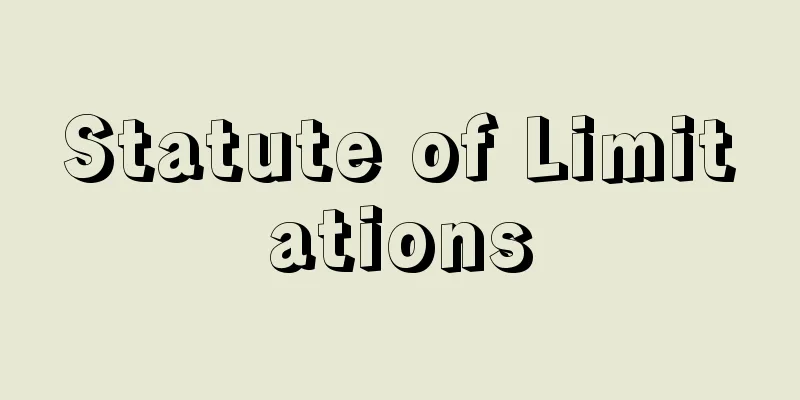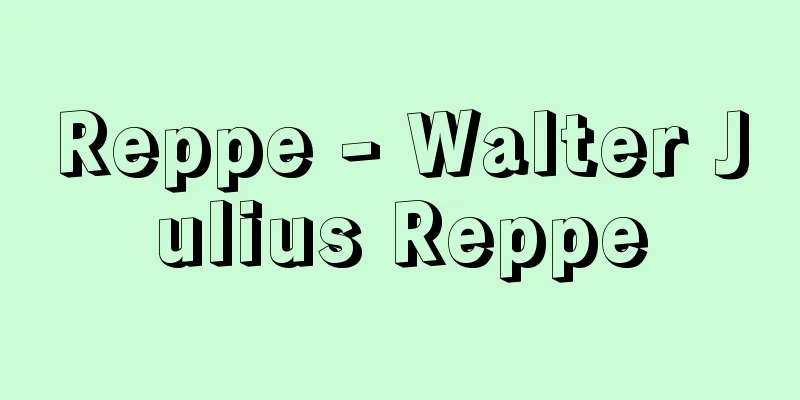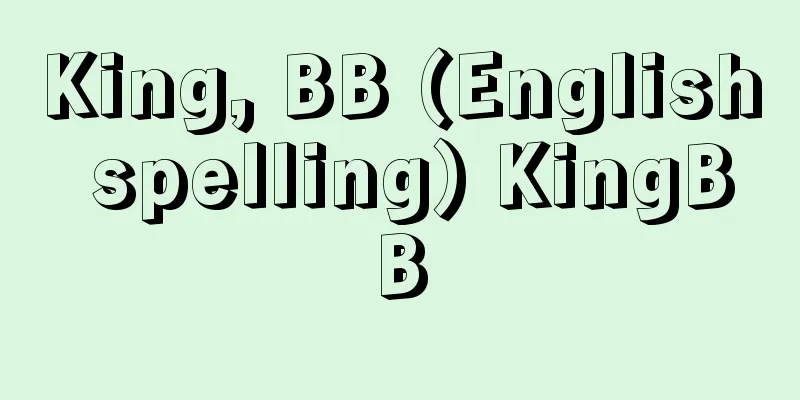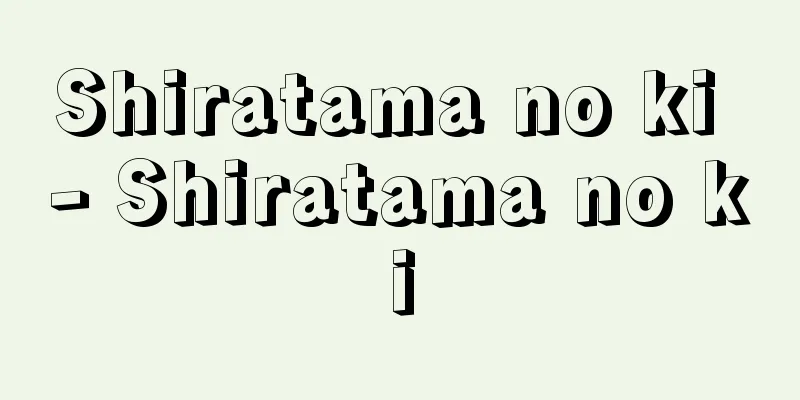Statute of Limitations

|
A system that respects a certain factual state that continues for a certain period of time, and recognizes the legal effects of the acquisition or loss of rights based on that factual state. [Takahisa Awaji] Prescription under private lawThere are acquisitive prescriptions and extinctive prescriptions. The former is a system that gives rights to those who occupy other people's property (such as land) for a long period of time (for example, according to Article 162 of the Civil Code, a person who has possessed it for 10 or 20 years acquires ownership. Although the article stipulates "other people's property," this does not mean that acquisitive prescription cannot be asserted for one's own property), and the latter is a system that extinguishes rights (mainly claims) that are not exercised for a certain period of time (according to Article 167 of the Civil Code, claims are extinguished if not exercised for 10 years). Note that extinctive prescriptions are similar to statutes of limitations, but are distinguished from them in that they are interrupted and require invocation. [Takahisa Awaji] Reason for the existence of the systemThe general theory on the reason for the existence of the statute of limitations lists the following three points, which are considered to be the unifying reasons that apply to all statute of limitations systems: (1) factual states that have continued for a long period of time need to be legally protected in order to stabilize legal relations, (2) those who neglect to exercise their rights and "sleep on their rights" do not deserve the protection of the law, and (3) proof becomes difficult over a long period of time, and therefore relief is required. However, this common theory has been criticized on the grounds that this unified explanation does not all apply to the various types of statute of limitations, and ideas from different perspectives have been advocated. For example, according to a leading theory that explains prescriptions from multiple perspectives, there are three types of prescriptions: (1) prescription for the extinction of claims (e.g. prescription for credit), (2) prescription for the extinction of other real rights (real rights established on the real rights of others) (e.g. prescription for surface rights), and (3) prescription for acquisition (e.g. acquisition of ownership), and each of them has a different reason for existence: (1) is a system that aims to release obligors by legal evidence, since the evidence of rights often becomes unclear with the passage of time, (2) is a system that serves the perfection of ownership, and (3) is a system that aims to stabilize the circulation of real rights transactions by easing the difficulty of proving title (legal cause that justifies the performance of a legal or factual act). In addition, there is also the viewpoint of whether prescription is a system that protects non-right holders or true right holders, and there is a theory that thinks it is a system that protects those who are not actually right holders but are premised on being right holders, as well as true right holders who cannot prove their rights. [Takahisa Awaji] Invocation of prescriptionThe expression of intent by a party to receive the benefit of the prescription is called invoking the prescription. The court cannot use the prescription as a basis for judgment simply because the prescription period has elapsed; the party must invoke it (Civil Code, Article 145). In this respect, it differs from the statute of limitations, which does not require invocation. It is explained that the reason why the party must invoke the prescription is that, for example, a person who has not made payment may not feel comfortable receiving the benefit of the prescription, so it was left to the discretion of one's conscience (conscience provision theory). Regarding the method of invocation, there is a precedent from the time of the Supreme Court that stated that in-judicial or extra-judicial invocation is acceptable. Academic theories differ on whether the effect of the prescription arises definitively with the passage of the prescription period (definite effect theory) or arises indefinitely and becomes definite through invocation (indefinite effect theory), and in the latter case, extra-judicial invocation is permitted (prevailing theory). Regarding persons with the right to invoke prescription, based on the general theory that those who directly benefit from prescription, include the debtor, joint debtor, guarantor, and real guarantor of the claim that is subject to prescription, and while third party acquirers of mortgaged real estate and beneficiaries of fraudulent acts were previously denied as persons with the right to invoke prescription, the Supreme Court ruled on December 14, 1973 and on June 22, 1998 that third party acquirers of mortgaged real estate and beneficiaries of fraudulent acts were recognized as persons with the right to invoke prescription. Academic theory interprets that all persons with a legal interest that asserts prescription may be persons with the right to invoke prescription. [Takahisa Awaji] Waiver of prescriptive benefitsThe expression of a party's intention not to receive the benefit of the prescription is called a waiver of the benefit of the prescription. The benefit of the prescription cannot be waived in advance before the prescription has run its course (Civil Code Article 146). The reason for this is to prevent the creditor from taking advantage of the debtor's financial difficulties to force the debtor to waive the benefit of the prescription in advance. Therefore, after the prescription has run its course, when there is no such risk, the benefit of the prescription can be waived. Furthermore, case law has stated that apart from the waiver of the benefit of the prescription, if the debtor acknowledges the debt, pays the debt, or submits a certificate of postponement after the prescription has run its course, the benefit of the prescription can no longer be invoked (loss of the right to invoke the prescription). [Takahisa Awaji] Interruption of PrescriptionWhen certain circumstances occur, the period that has passed up to that point becomes legally meaningless, and a new prescription period begins to run. This is the interruption of the prescription. There are three types of statutory interruption reasons: (1) claims (Civil Code Articles 149 to 153), (2) attachment, provisional attachment, and provisional disposition (Civil Code Articles 154 and 155), and (3) recognition of rights (Civil Code Article 156). These apply to both extinctive prescription and acquisitive prescription. In addition, acquisitive prescription is naturally interrupted by loss of possession (Civil Code Article 164). There is no interruption of the statute of limitations. [Takahisa Awaji] Suspension of PrescriptionIf there are circumstances that make it particularly difficult to exercise a claim right at the end of the prescription period (such as a natural disaster), the Civil Code provides for a postponement of the completion of the prescription (Articles 158 to 161). This is the suspension of the prescription. [Takahisa Awaji] Prescription period and starting point of prescriptionThe statute of limitations for claims is 10 years in principle (Civil Code, Article 167, Paragraph 1), while the statute of limitations for torts is interpreted as a statute of limitations of 3 years for the shortest period, and 20 years for the longest period. For commercial claims, it is 5 years (Commercial Code, Article 522). The Civil Code also provides for short-term statutes of limitations for certain claims (Civil Code, Articles 169-174), which include 5-year, 3-year, 2-year, and 1-year periods, and some have suggested that simplification is necessary in terms of legislative theory. The statute of limitations for claims begins when the right is exercised (Civil Code, Article 163, Paragraph 1), and for torts, it begins when the victim or his/her legal representative becomes aware of the damage and the tormentor (Civil Code, Article 724). Case law has determined that the statute of limitations begins when the victim becomes aware of the damage and the tormentor to the extent that it is possible to make a claim for compensation against the tormentor. Ownership rights do not expire by prescription. The prescription period for property rights that are not claims or ownership rights is 20 years (Article 167, Paragraph 2 of the same law). Case law has interpreted the prescription period for creation rights (such as the right to cancel) as being 10 years, in line with claims (Article 126 of the same law provides for the right to rescind, with a short-term time limit of 5 years and a long-term of 20 years interpreted as a statute of limitations). Acquisition of a right of possession is established by peacefully and openly possessing another person's property for a certain period of time with the intention to own in the case of ownership, or with the intention to act on one's own behalf in the case of property rights other than ownership (for a possessor, the intention to own, in good faith, peacefully and openly is presumed; Identical Law, Article 186), but the prescription period is 10 years if the possessor or quasi-possessor was in good faith and without negligence at the beginning of the possession or quasi-possession, and 20 years in other cases (Identical Law, Articles 162 and 163). [Takahisa Awaji] Criminal statute of limitationsThe extinction of the right to punish after a certain period of time has passed. Under current law, there is the "statute of limitations" and the "statute of limitations for prosecution," the former of which is stipulated in the Penal Code (Articles 31-34) and the latter in the Code of Criminal Procedure (Articles 250-255). In April 2010, the Penal Code and the Code of Criminal Procedure were amended to include major changes such as the abolition of the statute of limitations or an extension of its period depending on whether the statutory penalty includes the death penalty, in order to "ensure the proper exercise of the right to prosecute" for crimes that result in the death of a person, and these changes came into effect immediately. [Nawa Tetsuro January 19, 2018] Statute of LimitationsThis is a system that allows for exemption from execution if a person who has been sentenced to a certain period of time does not undergo execution of the sentence (see Article 31 of the Penal Code). With the 2010 amendment, the death penalty is no longer subject to the statute of limitations, and the statute of limitations has been extended to 30 years for life imprisonment, 20 years for fixed-term imprisonment or incarceration of 10 years or more, and 10 years for imprisonment or incarceration of 3 years or more but less than 10 years. Other than these, the statute of limitations remains the same as before: 5 years for imprisonment or incarceration of less than 3 years, 3 years for fines, and 1 year for detention, fines, and confiscation (Article 32 of the Penal Code). However, the 2010 amendment does not apply to the statute of limitations for sentences that were finalized before the amendment came into effect (in this respect it differs from the case of the statute of limitations for prosecution, which will be discussed later). The statute of limitations for a sentence does not run during the period in which execution is suspended or suspended by law (Article 33 of the Penal Code). In addition, the prescription for imprisonment, incarceration and detention is interrupted by the detention of the sentenced person for the execution of that sentence, but the prescription for fines, penalties and confiscation is interrupted by the act of execution (Article 34 of the same law). [Nawa Tetsuro January 19, 2018] Statute of LimitationsIf prosecution is not brought within a certain period, the right to prosecute is extinguished, and as a result, the right to punish itself is extinguished. When the statute of limitations has expired, a verdict must be issued acquitting the prosecution (Criminal Procedure Law, Article 337, Paragraph 4). Regarding the period of the statute of limitations, the Criminal Procedure Law, in regard to "crimes resulting in the death of a person and punishable by imprisonment or more," excludes crimes punishable by death (murder, robbery-murder/robbery resulting in death, robbery-forced sexual intercourse resulting in death, etc.) from the scope of the statute of limitations, and sets the period of the statute of limitations at 30 years for crimes punishable by life imprisonment or incarceration (forced indecency resulting in death, forced sexual intercourse resulting in death, sexual intercourse with a guardian resulting in death), 20 years for crimes punishable by imprisonment or incarceration of a maximum term of 20 years or more (injury resulting in death, dangerous driving resulting in death, arrest and confinement resulting in death), and 10 years for crimes other than these (negligent driving resulting in death, professional negligence resulting in death, involvement in suicide, and consensual murder). Article 250, paragraph 2, prescribes that for crimes other than those prescribed in paragraph 1, the sentences are 25 years for crimes punishable by death, 15 years for crimes punishable by life imprisonment, 10 years for crimes punishable by imprisonment with a maximum term of 15 years or more, 7 years for crimes punishable by imprisonment with a maximum term of less than 15 years, 5 years for crimes punishable by imprisonment with a maximum term of less than 10 years, 3 years for crimes punishable by imprisonment with a maximum term of less than 5 years or a fine, and 1 year for crimes punishable by detention or a fine. The statute of limitations runs from the time the criminal act is completed and is suspended by the initiation of prosecution (Articles 253, paragraph 1 and 254, paragraph 1 of the same law). In the case of accomplices, the period of the statute of limitations begins to run from the time the final act was completed for all accomplices, and the suspension of the statute of limitations due to the initiation of prosecution against one accomplice also has effect on the other accomplices (Articles 253, paragraph 2 and 254, paragraph 2 of the same law). In addition, if the perpetrator is outside the country or is in hiding and therefore it is not possible to effectively serve a certified copy of the indictment or to notify the person of a summary order, the statute of limitations will be suspended for that period (Article 255, Paragraph 1 of the same law). [Nawa Tetsuro January 19, 2018] Statute of limitations under public law (administrative law)Between national and local public entities and private individuals, the relationship is that of equal parties, and unless there is a special provision, the statute of limitations under the Civil Code applies. However, there are cases where special provisions are in place or special interpretations are made. This was previously called the statute of limitations under public law, but today there is no special legal system consisting of public and private law, and because of the unique nature of national and local public entities, only special systems are in place separately. However, because the law is unclear, there are many disputes over its interpretation in case law and academic theories, and there are many critical views of the case law. There are also extinct and acquired prescriptions under administrative law. [Yasuhito Abe] Statute of Limitations(1) Notices and demands for payment and the effect of interrupting the prescription Article 153 of the Civil Code provides that a demand has the effect of interrupting the prescription, but this effect will be lost if a lawsuit is not filed within six months. In contrast, Article 236, paragraph 4 of the Local Autonomy Law provides that "notices and demands for payment made by ordinary local public entities pursuant to the provisions of laws and regulations have the effect of interrupting the prescription, notwithstanding the provisions of Article 153 of the Civil Code (including the case where it applies mutatis mutandis in the preceding paragraph)" (Article 32 of the Accounting Law also has the same effect for the state. The following explanation of extinctive prescription will be given based on the Local Autonomy Law), and notices and demands for payment have the effect of interrupting the prescription without filing a lawsuit. Moreover, this is only in accordance with the provisions of laws and regulations, and is not limited to cases of private law acts, but applies to all claims held by local public entities. In other words, it is the subject theory. (2) Period of statute of limitations With regard to the period of statute of limitations, it is stipulated that "the right of an ordinary local public entity to pay money shall be extinguished by prescription if it is not exercised within five years, except for cases where other laws provide for the period of limitation." (Article 236, paragraph 1 of the Local Autonomy Law; Article 30 of the Accounting Law also provides the same for the national government.) There are two ways to interpret "provided by other laws" here. One is a dualistic interpretation of public law and private law, in which the Civil Code applies to acts under private law, and "other laws" here refer to administrative regulations other than the Civil Code. Examples include local taxes, national health insurance premiums (2 years), nursing care insurance premiums (2 years), settlement payments under the Land Readjustment Act, claims for collection of levies (5 years), and charges under the Road Act (5 years). The five-year statute of limitations under the Local Autonomy Act applies to claims under public law other than those mentioned above. This is the traditional interpretation. On the other hand, if we disregard the premise that there is a distinction between public law and private law and read the text faithfully, in principle the five-year statute of limitations of the Local Autonomy Act applies, and "except as provided for in other laws" means excluding cases with special provisions in administrative regulations, and the Civil Code does not apply from the start. This is, so to speak, a reading based on the subject theory. In case law, the claim for the proceeds of sale of ordinary assets was originally a claim under private law, and therefore the statute of limitations for such claim was not applicable to Article 30 of the Accounting Act, but was governed by the Civil Code (Supreme Court ruling of November 1, 1966). The same applies to the claim for recovery of the deposited money in the case of a payment deposit (Supreme Court ruling of July 15, 1970). However, in a Supreme Court ruling on February 25, 1975, while the statute of limitations for claims for damages against the state is 10 years according to Article 167, paragraph 1 of the Civil Code, it was interpreted that Article 30 of the Accounting Act applies to "monetary claims for which it is necessary to settle the rights and obligations of the state early" and "for which administrative convenience must be taken into consideration." The basis for this interpretation is difficult to understand and unclear, but considering that it focuses on the efficiency of administrative management, it seems to be close to the subject theory mentioned above. However, subsequently, with regard to the statute of limitations for civil claims, the court announced that it would maintain the former theory, which is premised on a distinction between public law and private law, and decided that the Civil Code applies, setting the statute of limitations for water charges at two years as stipulated in Article 173 of the Civil Code (Tokyo High Court, October 10, 2003). The Supreme Court also ruled that with regard to the statute of limitations for claims relating to medical treatment at public hospitals, there is no essential difference between medical treatment provided at public hospitals and medical treatment provided at private hospitals, and the legal relationship relating to such medical treatment should essentially be considered a private law relationship; therefore, the statute of limitations for claims relating to medical treatment at public hospitals should be interpreted as three years pursuant to Article 170, Paragraph 1 of the Civil Code, rather than five years as stipulated in Article 236, Paragraph 1 of the Local Autonomy Act (Supreme Court decision of November 21, 2005). Thus, since this provision was deemed to be meaningful as a provision that stipulates the extinctive prescription period for monetary claims under public law, the ghosts of public and private law are once again brought back to life. This seems to have resolved the issue in practice, but theoretically there is considerable criticism of it. First, the provision that states "five years, except as otherwise provided in other laws" would be considered to be five years unless there are special exceptions (i.e., for ordinary creditors and debtors), but such exceptions are difficult to find and do not conform to the intent of the law. Secondly, in today's world where the dualism of public and private law is no longer accepted, the provisions should be read straightforwardly. The Supreme Court's precedents do not seem to be of the opinion that it is natural to separate public and private law, and they do not refute the subject theory, nor clarify in what cases the five-year statute of limitations applies, which makes practical processing difficult. Thirdly, the dual theory of public and private law adopted in case precedents is complicated and detailed with regard to the retention periods for government documents, with public law claims being five years, while private law claims are governed by the Civil Code, with hospitals being three years (Civil Code Article 170), water charges being two years (Civil Code Article 173, item 1), public accommodation being one year (Civil Code Article 174), etc. It would be more efficient to set a uniform retention period based on the necessity for managing government documents. Fourth, with regard to the aforementioned notice and demand for payment, the special provisions on the effect of interrupting the prescription apply regardless of whether it is public law or private law, and Article 231-3, paragraph 3 of the Local Autonomy Act states that "fees prescribed by law" can be collected administratively (a system in which collection procedures can be implemented for delinquent payments without resorting to civil litigation, similar to taxes), regardless of whether it is public law or private law, so it is unnatural to interpret that the Civil Code applies with regard to the extinctive prescription and invocation. From the perspective of interpretation, it should have been understood that the intent of the law was to exclude the Civil Code from the outset in order to efficiently handle administrative affairs. Furthermore, if public hospitals thought that they only needed to bill over a five-year period, any amount exceeding three years would result in a huge deficit, and they would need to change their practices, such as how they manage claims and how they preserve documents. Rent for public housing, school lunch fees for compulsory education, and high school tuition fees would probably be treated as private law claims rather than public law claims, and would be governed by the Civil Code, but because these are not claims that are based on market principles, they should be considered public law claims. (3) Invocation of Prescription and Waiver of Interests "With regard to the extinguishment by prescription of the rights of ordinary local public entities which are for the payment of money, unless otherwise provided by law, the invocation of prescription is not required, and the interest cannot be waived. The same applies to rights against ordinary local public entities which are for the payment of money." (Article 236, paragraph 2 of the Local Autonomy Law and Article 31 of the Accounting Law also state the same thing). Against this issue, the traditional view has been that a distinction should be made between public law and private law, and that the Civil Code should be applied to claims under private law, and this is also the position taken by the Supreme Court. However, this would result in unfair disparities, depending on the intentions and practices of the administrative officials in charge. In addition, it would be troublesome for government offices to manage claims, as procedures for interrupting the prescription would be required. With regard to monetary claims in which the State is a party, the statute of limitations, which respects personal will, is excluded, and from the perspective of the public interest in which the State's accounts are maintained by the entire nation as taxpayers, prompt, uniform and fair processing is required. It should therefore be understood that there is no need to invoke the statute of limitations, and that the benefits of the statute of limitations cannot be waived. (4) Cases where asserting the statute of limitations is an abuse of rights In one case, a survivor who had been certified for the payment of a health care allowance under the Atomic Bomb Victims Assistance Law was denied payment of the unpaid health care allowance after the survivor left Japan for a foreign country. Hiroshima Prefecture, which asserted the statute of limitations as provided for in Article 236 of the Local Autonomy Law, lost the case. The statute of limitations expired because the plaintiff was unable to apply due to a national notification that applications could not be made from overseas. Hiroshima Prefecture's argument is that it was tantamount to attempting to avoid its obligation to pay on the grounds that the beneficiaries did not exercise their rights, despite having accepted the task from the national government, which had made it difficult for eligible recipients to exercise their rights by issuing illegal notifications, and having carried out illegal administrative procedures itself; and that, absent special circumstances, this is a breach of the principle of good faith and is therefore impermissible (Case on Claims for Health Management Allowances for Atomic Bomb Survivors in Brazil, Supreme Court Judgment of February 6, 2007). [Yasuhito Abe] Prescription acquisition of public propertyVillage roads, footpaths, waterways, and beaches are public property owned by the state, but before you know it, the public property ceases to exist as public property, and private individuals occupy them and claim acquisitive prescription. There was once a theory that the acquisitive prescription of the Civil Code does not apply to this so-called acquisitive acquisition of public property because it is a public law relationship, but when acquisitive acquisition becomes an issue, the property is no longer managed as public property, so the Civil Code should apply. The Supreme Court (December 24, 1976) ruled that in this case, "public use was implicitly abolished," and therefore acquisitive prescription does not stand in the way. However, even without such elaborate explanations, when the property is used as public property, it does not meet the requirements of Article 162 of the Civil Code, which states that "a person peacefully and openly possesses another person's property with the intention of owning it," so it is sufficient to make a judgment based on the Civil Code. [Yasuhito Abe] "A Study of Acquired Prescriptions" by Kusano Motomi (1996, Shinzansha Publishing)" ▽ "Reconstructing Prescription Theory" by Oki Yasushi (2000, Seibundo)" ▽ "Prescriptions and Justice - New Stirrings in the Theory of Lapse Prescriptions and Statute of Limitations" by Matsumoto Katsumi (2002, Nippon Hyoronsha)" ▽ "The Structure and Interpretation of the Prescription System" by Matsuhisa Sanshihiko (2011, Yuhikaku)" ▽ "Prescriptions and Justice - Continued (New Developments in the Theory of Lapse Prescriptions and Statute of Limitations)" by Matsumoto Katsumi (2012, Nippon Hyoronsha)" [Reference] | | | | | | | |Source: Shogakukan Encyclopedia Nipponica About Encyclopedia Nipponica Information | Legend |
|
一定の事実状態が一定期間継続した場合に、この事実状態を尊重し、これに対して権利の取得・喪失という法律効果を認めようとする制度。 [淡路剛久] 私法上の時効取得時効と消滅時効とがある。前者は長期間にわたって他人の物(たとえば土地)を占有する者に権利を与える制度であり(たとえば、民法162条により、10年または20年占有した者は、所有権を取得する。なお、条文に「他人の物」と規定されているが、自己の物について取得時効を主張できないわけではない)、後者は一定期間行使されない権利(主要なものは債権)を消滅させる制度である(民法167条により、債権は、10年間行使しないときは消滅する)。なお、消滅時効は除斥期間に類似するが、中断があること、および援用を必要とする点でそれとは区別される。 [淡路剛久] 制度の存在理由時効制度の存在理由について、一般の学説は次の3点をあげ、これをもって、すべての時効制度に通じる統一的理由とする。すなわち、(1)長期間継続した事実状態は、法律関係を安定させるために法的に保護する必要があること、(2)権利行使を怠り「権利のうえに眠っている者」は法の保護に値しないこと、(3)長期間の経過によって立証が困難となり、したがってこれを救済する必要があること、の3点である。しかし、このような通説に対しては、多様な種類の時効についてこれらの一元的な説明がすべてあてはまるわけではないとの批判があり、異なった観点からの考え方が唱えられている。たとえば、多元的に説明する有力な学説によれば、時効には、(1)請求権の消滅時効(たとえば債権の消滅時効)、(2)他物権(他人の物権のうえに成立する物権)の消滅時効(たとえば地上権の消滅時効)、および(3)取得時効(たとえば所有権の取得時効)の三つがあって、それらはそれぞれ制度の存在理由を異にし、(1)は、期間の経過によって権利関係の証拠が不明確となることが多いので、法定証拠によって義務者を解放することを目的とする制度であり、(2)は、所有権の完全円満性に奉仕する制度であり、(3)は、権原(ある法律的または事実的行為をなすことを正当とする法律上の原因)の証明の困難を容易にすることによって物権取引の流通を安定させることを目的とする制度である、としている。また、時効は非権利者を保護する制度か真の権利者を保護する制度か、という観点もあり、本当は権利者でないが、それを前提としているものを保護するとともに、権利を証明できない真の権利者を保護する制度だと考える説もある。 [淡路剛久] 時効の援用時効の利益を受ける旨の当事者の意思表示を時効の援用という。時効は、単に時効期間が経過しただけでは裁判所はこれによって裁判することができず、当事者が援用しなければならない(民法145条)。この点で援用を必要としない除斥期間と異なる。時効について当事者の援用を必要としたのは、たとえば弁済をしていない者が時効の利益を受けることを潔しとしないことがあるので、自らの良心に任せようとした趣旨だと説明されている(良心規定説)。援用の方法については、裁判上でも裁判外の援用でもよい、とした大審院時代の判例がある。学説は、時効の効果が時効期間の経過により確定的に生じると考えるか(確定効果説)、不確定的に生じて、援用により確定すると考えるか(不確定効果説)で異なり、後者では裁判外の援用を認めてよいこととなる(通説)。援用権者につき判例は、時効によって直接に利益を受ける者との一般論のもとで、時効にかかった債権の債務者・連帯債務者・保証人・物上保証人はこれに該当するとし、抵当不動産の第三取得者、詐害行為の受益者については、かつては否定したが、抵当不動産の第三取得者に関しては1973年12月14日最高裁判決で、詐害行為の受益者に関しては1998年6月22日最高裁判決で、援用権者と認めるに至った。学説は、時効の主張をなす法律上の利益を有する者すべてを援用権者としてよいと解している。 [淡路剛久] 時効利益の放棄時効の利益を受けない旨の当事者の意思表示を時効利益の放棄という。時効の利益は、時効完成前あらかじめ放棄することは認められない(民法146条)。その理由は、債務者が窮迫に乗じられて債権者によってあらかじめ時効の利益を放棄させられることを防止することにある。したがって、そのような危険がない時効完成後においては、時効の利益を放棄することが認められている。なお、判例は、時効利益の放棄とは別に時効完成後に債務者が債務を承認したり、弁済したり、延期証を差し入れたような場合には、もはや援用できない、としている(時効援用権の喪失)。 [淡路剛久] 時効の中断一定の事由があった場合には、それまで経過した期間は法律上無意味なものとされ、新たに時効期間が進行し始める。これが時効の中断である。法定中断事由には、(1)請求(民法149条~153条)、(2)差押え・仮差押え・仮処分(同法154条、155条)、(3)権利の承認(同法156条)の3種類があり、これらは消滅時効および取得時効の両方に適用される。このほか、取得時効には占有の喪失という自然中断事由がある(同法164条)。なお、除斥期間には、中断がない。 [淡路剛久] 時効の停止時効期間の終わりにおいて請求権を行使することがとくに困難な事情(たとえば天災地変など)にある場合には、民法は時効の完成を猶予する(158条~161条)。これが時効の停止である。 [淡路剛久] 時効期間と時効の起算点債権の消滅時効期間は原則として10年(民法167条1項)、不法行為の時効は、短期の期間制限が3年の消滅時効であり、長期の20年は除斥期間と解されている。商事債権は5年(商法522条)である。なお民法は、特定の債権については短期消滅時効を定めており(同法169条~174条)、それによると、5年、3年、2年、1年のものがあり、立法論として、単純化が必要との意見がある。債権の消滅時効の起算点は、権利を行使する時から(同法163条1項)であり、不法行為については、被害者またはその法定代理人が損害および加害者を知ったときから(同法724条)と定められている。これは被害者が加害者に対する賠償請求が事実上可能な状況のもとで、可能な程度に知ったとき、とするのが判例である。 所有権は時効消滅しない。債権または所有権でない財産権の消滅時効期間は20年である(同法167条2項)。形成権(たとえば解除権)の時効期間については、判例は債権に準じて10年と解している(取消権については同法126条で特別に規定され、短期の期間制限が5年、長期の20年は除斥期間と解されている)。 取得時効は、所有権の場合には所有の意思をもって、所有権以外の財産権の場合には自己のためにする意思をもって、平穏かつ公然に、他人の物を一定期間占有することによって成立する(占有者については、所有の意思、善意、平穏、公然は、推定される。同法186条)が、その時効期間は、占有者・準占有者が占有・準占有の始めに善意無過失の場合には10年、その他の場合には20年である(同法162条、163条)。 [淡路剛久] 刑事法上の時効一定期間が経過したことにより、刑罰権を消滅させること。現行法上、「刑の時効」と「公訴時効」とがあり、前者は刑法(31条~34条)で、後者は刑事訴訟法(250条~255条)で規定されている。なお、2010年(平成22)4月、刑法および刑事訴訟法改正により、人を死亡させた犯罪に対して「適正な公訴権の行使を図るため」として、法定刑に死刑が含まれるか否かによって、公訴時効の廃止やその期間延長などの大きな変更が行われ、即日施行された。 [名和鐵郎 2018年1月19日] 刑の時効刑の言渡しを受けた者が、一定の期間内にその執行を受けない場合、その執行を免除しうる制度である(刑法31条参照)。2010年改正により、死刑は刑の時効の対象外となり、時効の期間は、無期の懲役または禁錮が30年、10年以上の有期の懲役または禁錮が20年、3年以上10年未満の懲役または禁錮が10年と延長された。それら以外は従来と同様に、3年未満の懲役または禁錮が5年、罰金が3年、拘留・科料および没収が1年と規定されている(同法32条)。ただし、2010年改正は、施行前に確定した刑の時効については適用されない(この点で後述する公訴時効の場合とは異なる)。なお、刑の時効は、法令により執行を猶予し、または停止した期間内は進行しない(同法33条)。また、懲役、禁錮および拘留の時効は、刑の言渡しを受けた者を、その執行のために拘束することによって中断するが、罰金、科料および没収の時効は、執行行為によって中断する(同法34条)。 [名和鐵郎 2018年1月19日] 公訴時効一定の期間内に公訴が提起されない場合、公訴権を消滅させ、結果的に刑罰権そのものが消滅する制度である。公訴時効が完成したときは、判決で免訴の言渡しをしなければならない(刑事訴訟法337条4号)。公訴時効の期間について刑事訴訟法は、「人を死亡させた罪であって禁錮以上の刑に当たるもの」に関しては、第250条1項で、死刑にあたる罪(殺人、強盗殺人・強盗致死、強盗強制性交等致死など)を公訴時効の対象から除外したうえで、無期の懲役または禁錮にあたる罪(強制わいせつ致死、強制性交等致死、監護者性交等致死)を30年、長期20年以上の懲役または禁錮にあたる罪(傷害致死、危険運転致死、逮捕監禁致死)を20年、これらの罪以外の罪(自動車運転過失致死、業務上過失致死、自殺関与および同意殺人)を10年としている。そして、第250条2項は、1項が規定する罪以外の罪について、死刑にあたる罪を25年、無期の懲役・禁錮にあたる罪を15年、長期15年以上の懲役・禁錮にあたる罪を10年、長期15年未満の懲役・禁錮にあたる罪を7年、長期10年未満の懲役・禁錮にあたる罪を5年、長期5年未満の懲役・禁錮または罰金にあたる罪を3年、拘留・科料にあたる罪を1年と規定している。公訴時効は、犯罪行為が終わった時から進行し、公訴の提起によって停止する(同法253条1項、254条1項)。共犯の場合には、最終の行為が終わった時から、すべての共犯に対して時効の期間を起算し、共犯の一人に対する公訴の提起による時効の停止は、他の共犯に対しても、その効力を有する(同法253条2項、254条2項)。また、犯人が国外にいる場合または犯人が逃げ隠れているため起訴状の謄本の送達や略式命令の告知が有効にできなかった場合、その期間は時効の進行が停止する(同法255条1項)。 [名和鐵郎 2018年1月19日] 公法(行政法)上の時効国・地方公共団体と私人の間でも、対等当事者の関係で、特別の規定がなければ民法上の時効制度が適用される。しかし、これについて特別の規定がおかれていたり、特別の解釈がなされることがある。これを従来公法上の時効と称していたが、今日、公法と私法という特別の法体系は存在せず、国・地方公共団体については、その特殊性から、特別の制度が個別におかれるにとどまっている。しかし、法律が不明確なため、その解釈については、判例学説上争いが多いし、判例にも批判的な見解も少なくない。 行政法上の時効にも消滅時効と取得時効がある。 [阿部泰隆] 消滅時効(1)納入の通知・督促と時効中断の効力 (2)消滅時効期間 一つは、公法と私法二元論的な読み方で、私法上の行為については民法が適用され、ここでいう「他の法律」とは民法以外の行政法規をいうとする。地方税や国民健康保険料(2年)、介護保険料(2年)、区画整理法の清算金、賦課金の徴収債権(5年)、道路法による負担金(5年)等がそれである。地方自治法の5年の時効が適用されるのはそれ以外の公法上の債権についてである。これが伝統的な読み方である。 これに対して、公法と私法等の区別があるとの前提を取り払って、文理に忠実に読めば、原則は、地方自治法の消滅時効5年の適用があることになり、「他の法律に定めがあるものを除くほか」とは、行政法規に特例があるものを除き、という意味であり、はじめから民法は適用されないことになる。これはいわば主体説的読み方である。 判例では、もともと、普通財産の売却代金債権は私法上の債権であるから、その消滅時効について、会計法第30条の適用がなく、民法によるとしていた(1966年11月1日最高裁判決)。弁済供託における供託金取戻請求権についても同様である(1970年7月15日最高裁判決)。 しかし、1975年2月25日最高裁判決では、国に対する損害賠償請求権の時効は民法第167条1項により10年であるとしながらも、「国の権利義務を早期に決裁する必要があるなど」「行政上の便宜を考慮する必要がある金銭債権」には会計法第30条が適用されるとの解釈が示された。この解釈の根拠はわかりにくく、明確ではないが、行政運営の効率性に着目していることに注目すれば、前記の主体説に近いのではないかとも思われた。 ところが、その後、民事上の債権の消滅時効については、公法と私法の区別を前提とする前者の説を維持することを表明し、民法の適用があるとして、水道料金の消滅時効期間を民法第173条所定の2年間とする判例が出た(東京高裁2003年10月10日)。 また最高裁は、公立病院における診療に関する債権の消滅時効期間について、公立病院において行われる診療は、私立病院において行われる診療と本質的な差異はなく、その診療に関する法律関係は本質上私法関係というべきであるから、公立病院の診療に関する債権の消滅時効期間は、地方自治法第236条1項所定の5年ではなく、民法第170条1号により3年と解すべきであるとした(2005年11月21日最高裁判決)。 こうして、この規定は、公法上の金銭債権について消滅時効期間を定めた規定として意味があるとされたので、ここではまたまた公法と私法の亡霊が生き返っている。これで実務上は解決されたかと思われるが、理論的には、これに対する批判は少なくない。 まず、「他の法律に定めのあるものを除くほか、5年」とする規定は、特例がなければ(つまりは、通常の債権債務は)5年と考えられるのに、それがなかなか見つからず、法の趣旨にあわない。 第二に、公法と私法の二元論が認められなくなった今日では、条文を素直に読むべきである。最高裁判例が、公法と私法を分けるのは当然のことというつもりなのか、主体説に反論しておらず、どのような場合に5年の時効の適用があるかも明らかにしていないのでは実務上の処理も困る。 第三に、判例のとる公法と私法二元説は、役所の文書の保存期間について、公法上の債権なら5年、私法上の債権なら民法の適用があり、病院は3年(民法170条)、水道料金は2年(同法173条1号)、公営宿舎は1年(同法174条)などと、細分化され複雑である。役所の文書の管理の必要性に応じて一律に決めてしまうほうが効率的である。 第四に、先に述べた納入の通知・督促については、公法私法を問わず時効中断の効力の特則が適用されるし、地方自治法第231条の3第3項は、公法私法にとらわれず、「法律で定める使用料」について行政徴収(税金と同様、民事訴訟によらずに滞納処分できる制度)できるとしているのに、消滅時効、援用については民法の適用があると解するのも不自然である。 解釈論としても、行政事務の効率的な処理のために、民法をはじめから主体説的に排除するのが法の趣旨と解すべきであった。 なお、公立病院では、5年の間に請求すればよいと思っていたら、3年を超えた分は不納欠損になるので大赤字であり、債権管理の仕方、書類保存の仕方など、実務の変更が必要になる。公営住宅の家賃、義務教育の給食費、高校の授業料なども、おそらくは、公法上の債権ではなく、私法上の債権として、民法によることになろうが、これらは市場原理で成り立つ債権ではないから、公法上の債権というべきであろう。 (3)時効の援用と利益の放棄 (4)時効の主張が権利濫用になる場合 これは、国外からは申請できないとの国の通達があったため、原告が申請できずに時効期間が徒過したもので、広島県の主張は、違法な通達を定めて受給権者の権利行使を困難にしていた国から事務を受託し、自らも違法な事務処理をしていたにもかかわらず、受給権者の権利の不行使を理由として支払義務を免れようとするに等しいものであり、特段の事情のない限り、信義則に反し許されないとするものである(在ブラジル被爆者健康管理手当等請求事件、2007年2月6日最高裁判決)。 [阿部泰隆] 公物の時効取得里道、畦道(あぜみち)、水路、海浜地などは国有の公物であるが、いつの間にか公共の用に供するという、公物の実態がなくなり、私人が占拠して、取得時効を主張することがある。このいわゆる公物の時効取得については、かつては、公法関係であるから、民法の取得時効の適用はないとの説もあったが、時効取得が問題となるときは、すでに公物として管理されていないのであるから、民事法の適用があるとすべきである。最高裁(1976年12月24日判決)は、この場合に「黙示的に公用が廃止された」として取得時効の成立を妨げないとしたが、そのような技巧的な説明をせずとも、公物として利用されているときは、「所有の意思をもって、平穏に、かつ、公然と他人の物を占有した」という民法第162条の要件を満たさないのであるから、民法に即して判断すれば十分である。 [阿部泰隆] 『草野元己著『取得時効の研究』(1996・信山社出版)』▽『大木康著『時効理論の再構築』(2000・成文堂)』▽『松本克美著『時効と正義――消滅時効・除斥期間論の新たな胎動』(2002・日本評論社)』▽『松久三四彦著『時効制度の構造と解釈』(2011・有斐閣)』▽『松本克美著『時効と正義 続(消滅時効・除斥期間論の新たな展開)』(2012・日本評論社)』 [参照項目] | | | | | | | |出典 小学館 日本大百科全書(ニッポニカ)日本大百科全書(ニッポニカ)について 情報 | 凡例 |
Recommend
Azuma Mondo
A Muromachi period treatise on renga. Also known a...
British and North American Mail Carrier Charter Steamship Company
…In the mid-19th century, Britain accounted for o...
Silver Buddha
A silver cast Buddha. It is believed that this was...
Polar Urals
The Ural Mountains begin in the north on the Arct...
Handprint - Tegata
〘noun〙① A hand shape. A shape made by pressing ink...
"Epigraphy" - Kinseki Mojiki
…The study of stone carvings in the Song Dynasty ...
Single blind test
...In other words, the efficacy and safety for th...
Amabaha Collection - Amabaha Collection
…The Municipal Museum of Art in Basel, Switzerlan...
Genpo Tsujihara
1622-? A Confucian scholar and writer of kana zos...
Kiyomi [village] - Kiyomi
A village in Ono County, northern Gifu Prefecture....
haematocoel
…Blood from tissue spaces throughout the body col...
De facto government - English spelling: de facto government
A de facto government is a government that is esta...
Guo Maochen
...Chinese military man. His pen name was Maochen...
Contratenor bassus (English spelling)
...Male alto singer. In the mid-15th century, the...
Ami [town] - Ami
A town in Inashiki County, occupying the plateau s...









